ICT700 - System Analysis and Design: Australian Fashion Design Report
VerifiedAdded on 2024/06/03
|24
|4068
|442
Report
AI Summary
This report provides a system analysis and design for Australian Fashion Design (AFD), a Brisbane-based company specializing in women's clothing. It explores various development methodologies such as Agile, Spiral, Iterative, and Incremental, recommending the Agile methodology for AFD's system development. The report includes a memo explaining recommendations and a UCD approach, along with an event table, domain model class diagram, design class diagram, and use case diagram. It discusses the importance of HCL and UCD in creating a user-friendly system and suggests modifications to the existing stock control and customer relationship systems. The aim is to shift the business online, enhancing efficiency and customer service. The report concludes with references to support the analysis and design recommendations.
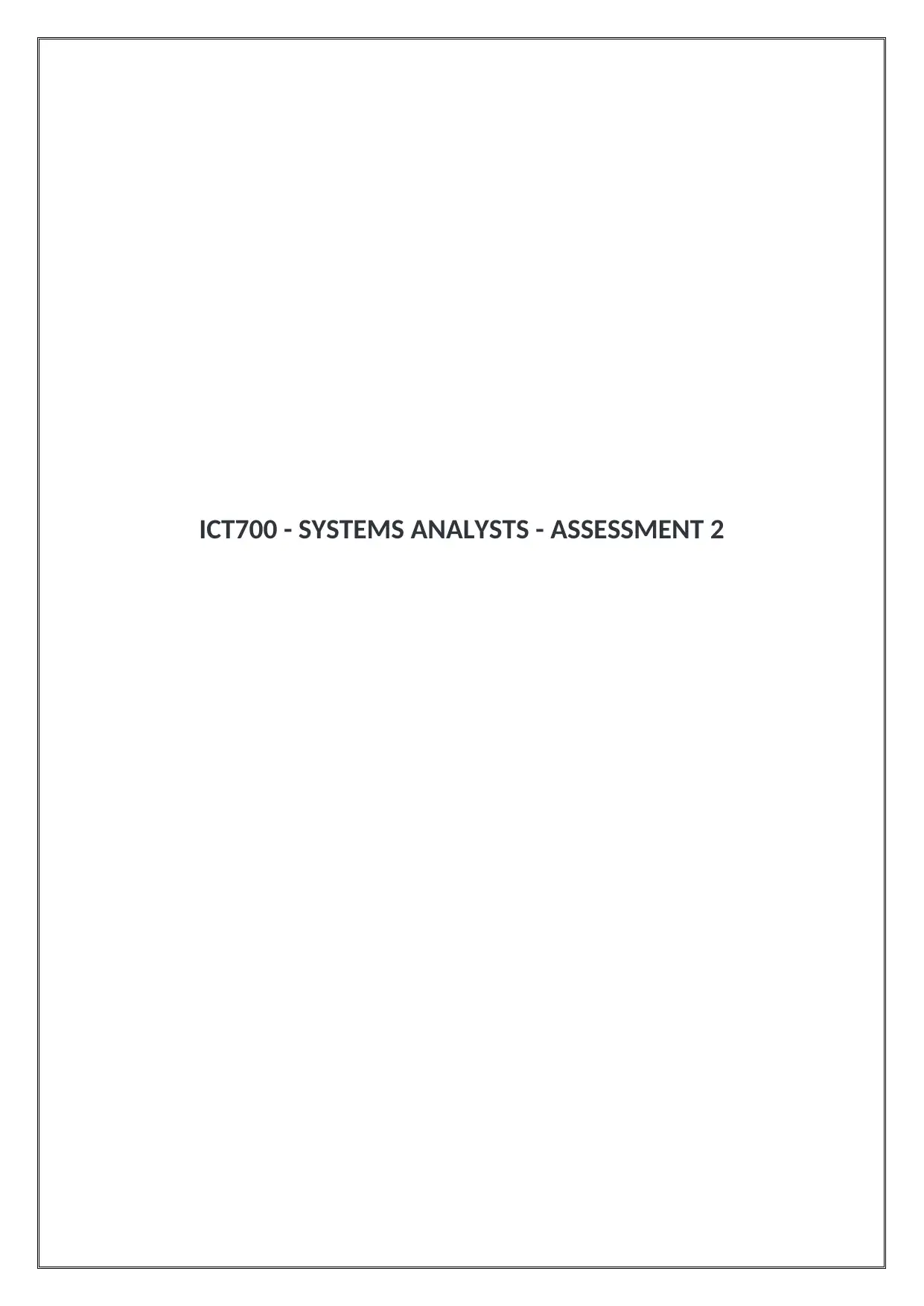
ICT700 - SYSTEMS ANALYSTS - ASSESSMENT 2
Paraphrase This Document
Need a fresh take? Get an instant paraphrase of this document with our AI Paraphraser
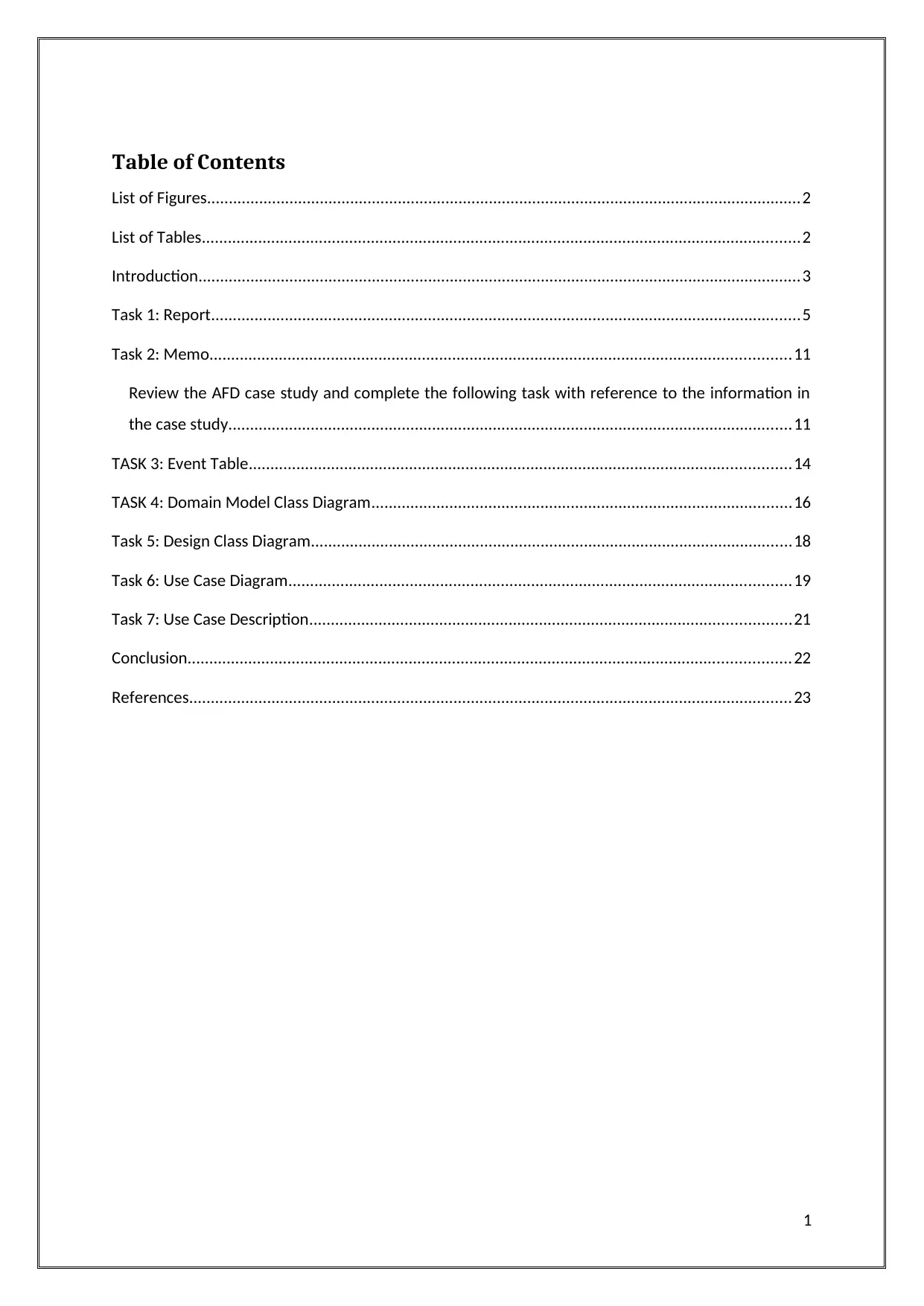
Table of Contents
List of Figures.........................................................................................................................................2
List of Tables..........................................................................................................................................2
Introduction...........................................................................................................................................3
Task 1: Report........................................................................................................................................5
Task 2: Memo......................................................................................................................................11
Review the AFD case study and complete the following task with reference to the information in
the case study..................................................................................................................................11
TASK 3: Event Table.............................................................................................................................14
TASK 4: Domain Model Class Diagram.................................................................................................16
Task 5: Design Class Diagram...............................................................................................................18
Task 6: Use Case Diagram....................................................................................................................19
Task 7: Use Case Description...............................................................................................................21
Conclusion...........................................................................................................................................22
References...........................................................................................................................................23
1
List of Figures.........................................................................................................................................2
List of Tables..........................................................................................................................................2
Introduction...........................................................................................................................................3
Task 1: Report........................................................................................................................................5
Task 2: Memo......................................................................................................................................11
Review the AFD case study and complete the following task with reference to the information in
the case study..................................................................................................................................11
TASK 3: Event Table.............................................................................................................................14
TASK 4: Domain Model Class Diagram.................................................................................................16
Task 5: Design Class Diagram...............................................................................................................18
Task 6: Use Case Diagram....................................................................................................................19
Task 7: Use Case Description...............................................................................................................21
Conclusion...........................................................................................................................................22
References...........................................................................................................................................23
1
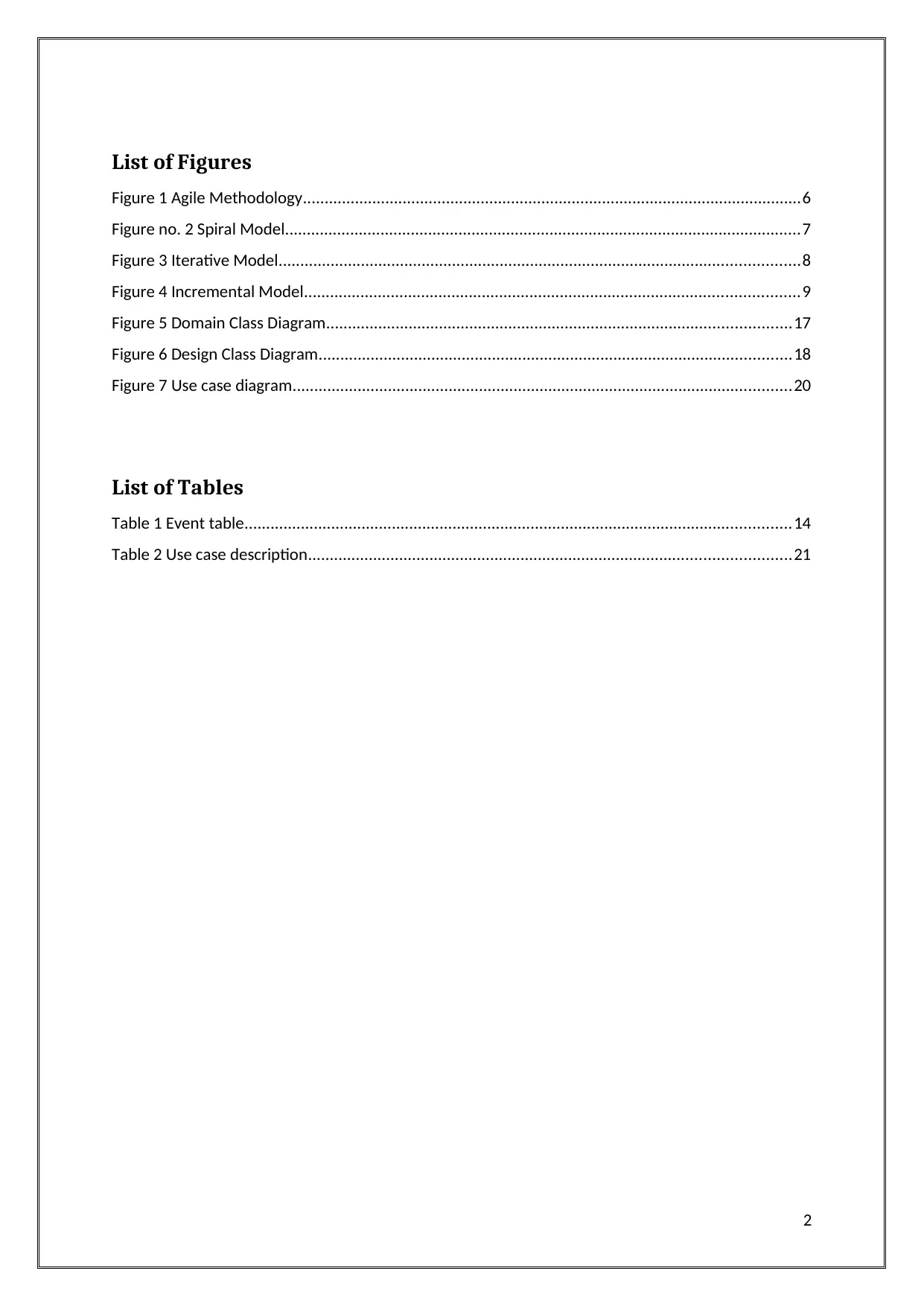
List of Figures
Figure 1 Agile Methodology...................................................................................................................6
Figure no. 2 Spiral Model.......................................................................................................................7
Figure 3 Iterative Model........................................................................................................................8
Figure 4 Incremental Model..................................................................................................................9
Figure 5 Domain Class Diagram...........................................................................................................17
Figure 6 Design Class Diagram.............................................................................................................18
Figure 7 Use case diagram...................................................................................................................20
List of Tables
Table 1 Event table..............................................................................................................................14
Table 2 Use case description...............................................................................................................21
2
Figure 1 Agile Methodology...................................................................................................................6
Figure no. 2 Spiral Model.......................................................................................................................7
Figure 3 Iterative Model........................................................................................................................8
Figure 4 Incremental Model..................................................................................................................9
Figure 5 Domain Class Diagram...........................................................................................................17
Figure 6 Design Class Diagram.............................................................................................................18
Figure 7 Use case diagram...................................................................................................................20
List of Tables
Table 1 Event table..............................................................................................................................14
Table 2 Use case description...............................................................................................................21
2
⊘ This is a preview!⊘
Do you want full access?
Subscribe today to unlock all pages.

Trusted by 1+ million students worldwide
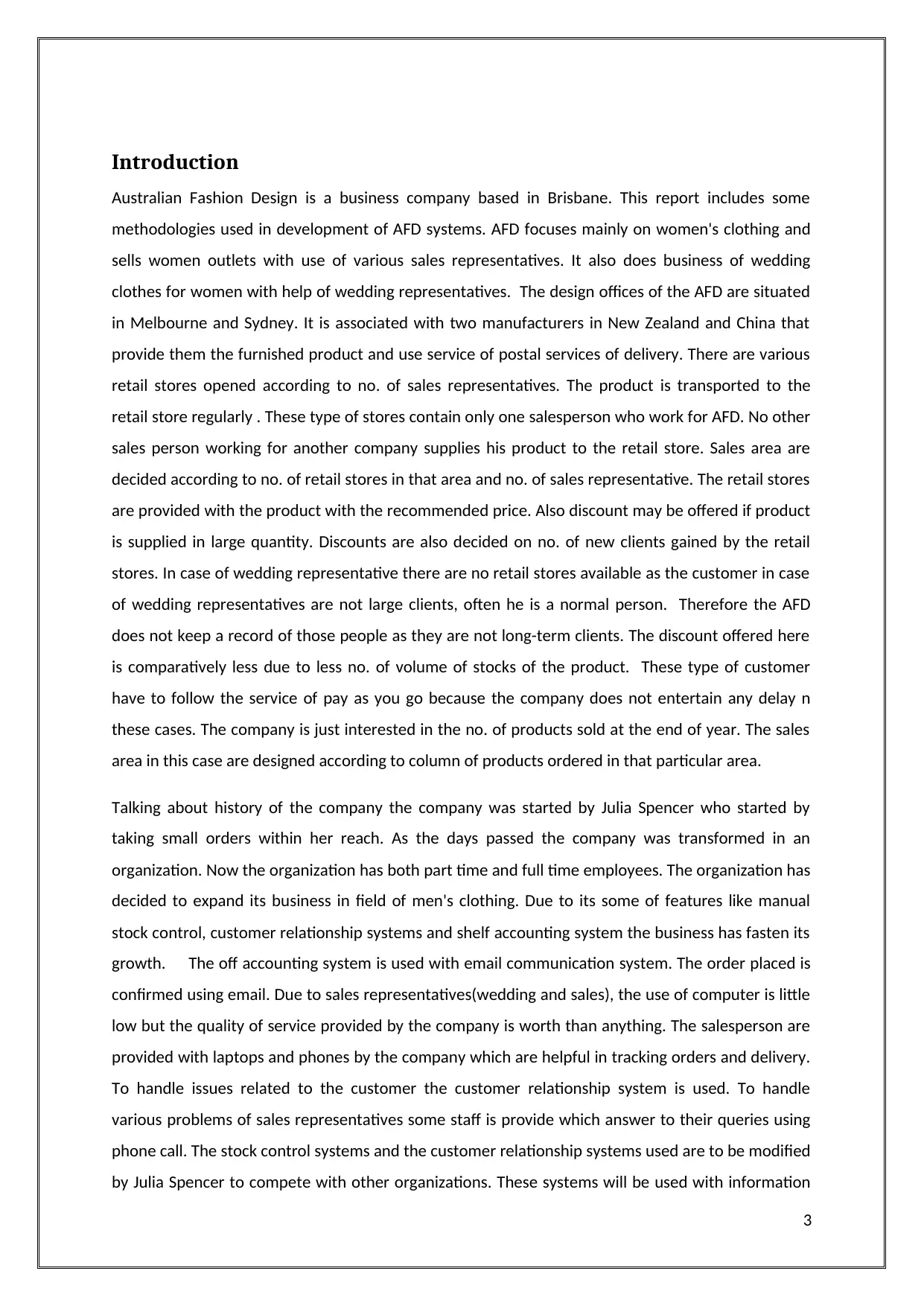
Introduction
Australian Fashion Design is a business company based in Brisbane. This report includes some
methodologies used in development of AFD systems. AFD focuses mainly on women's clothing and
sells women outlets with use of various sales representatives. It also does business of wedding
clothes for women with help of wedding representatives. The design offices of the AFD are situated
in Melbourne and Sydney. It is associated with two manufacturers in New Zealand and China that
provide them the furnished product and use service of postal services of delivery. There are various
retail stores opened according to no. of sales representatives. The product is transported to the
retail store regularly . These type of stores contain only one salesperson who work for AFD. No other
sales person working for another company supplies his product to the retail store. Sales area are
decided according to no. of retail stores in that area and no. of sales representative. The retail stores
are provided with the product with the recommended price. Also discount may be offered if product
is supplied in large quantity. Discounts are also decided on no. of new clients gained by the retail
stores. In case of wedding representative there are no retail stores available as the customer in case
of wedding representatives are not large clients, often he is a normal person. Therefore the AFD
does not keep a record of those people as they are not long-term clients. The discount offered here
is comparatively less due to less no. of volume of stocks of the product. These type of customer
have to follow the service of pay as you go because the company does not entertain any delay n
these cases. The company is just interested in the no. of products sold at the end of year. The sales
area in this case are designed according to column of products ordered in that particular area.
Talking about history of the company the company was started by Julia Spencer who started by
taking small orders within her reach. As the days passed the company was transformed in an
organization. Now the organization has both part time and full time employees. The organization has
decided to expand its business in field of men's clothing. Due to its some of features like manual
stock control, customer relationship systems and shelf accounting system the business has fasten its
growth. The off accounting system is used with email communication system. The order placed is
confirmed using email. Due to sales representatives(wedding and sales), the use of computer is little
low but the quality of service provided by the company is worth than anything. The salesperson are
provided with laptops and phones by the company which are helpful in tracking orders and delivery.
To handle issues related to the customer the customer relationship system is used. To handle
various problems of sales representatives some staff is provide which answer to their queries using
phone call. The stock control systems and the customer relationship systems used are to be modified
by Julia Spencer to compete with other organizations. These systems will be used with information
3
Australian Fashion Design is a business company based in Brisbane. This report includes some
methodologies used in development of AFD systems. AFD focuses mainly on women's clothing and
sells women outlets with use of various sales representatives. It also does business of wedding
clothes for women with help of wedding representatives. The design offices of the AFD are situated
in Melbourne and Sydney. It is associated with two manufacturers in New Zealand and China that
provide them the furnished product and use service of postal services of delivery. There are various
retail stores opened according to no. of sales representatives. The product is transported to the
retail store regularly . These type of stores contain only one salesperson who work for AFD. No other
sales person working for another company supplies his product to the retail store. Sales area are
decided according to no. of retail stores in that area and no. of sales representative. The retail stores
are provided with the product with the recommended price. Also discount may be offered if product
is supplied in large quantity. Discounts are also decided on no. of new clients gained by the retail
stores. In case of wedding representative there are no retail stores available as the customer in case
of wedding representatives are not large clients, often he is a normal person. Therefore the AFD
does not keep a record of those people as they are not long-term clients. The discount offered here
is comparatively less due to less no. of volume of stocks of the product. These type of customer
have to follow the service of pay as you go because the company does not entertain any delay n
these cases. The company is just interested in the no. of products sold at the end of year. The sales
area in this case are designed according to column of products ordered in that particular area.
Talking about history of the company the company was started by Julia Spencer who started by
taking small orders within her reach. As the days passed the company was transformed in an
organization. Now the organization has both part time and full time employees. The organization has
decided to expand its business in field of men's clothing. Due to its some of features like manual
stock control, customer relationship systems and shelf accounting system the business has fasten its
growth. The off accounting system is used with email communication system. The order placed is
confirmed using email. Due to sales representatives(wedding and sales), the use of computer is little
low but the quality of service provided by the company is worth than anything. The salesperson are
provided with laptops and phones by the company which are helpful in tracking orders and delivery.
To handle issues related to the customer the customer relationship system is used. To handle
various problems of sales representatives some staff is provide which answer to their queries using
phone call. The stock control systems and the customer relationship systems used are to be modified
by Julia Spencer to compete with other organizations. These systems will be used with information
3
Paraphrase This Document
Need a fresh take? Get an instant paraphrase of this document with our AI Paraphraser
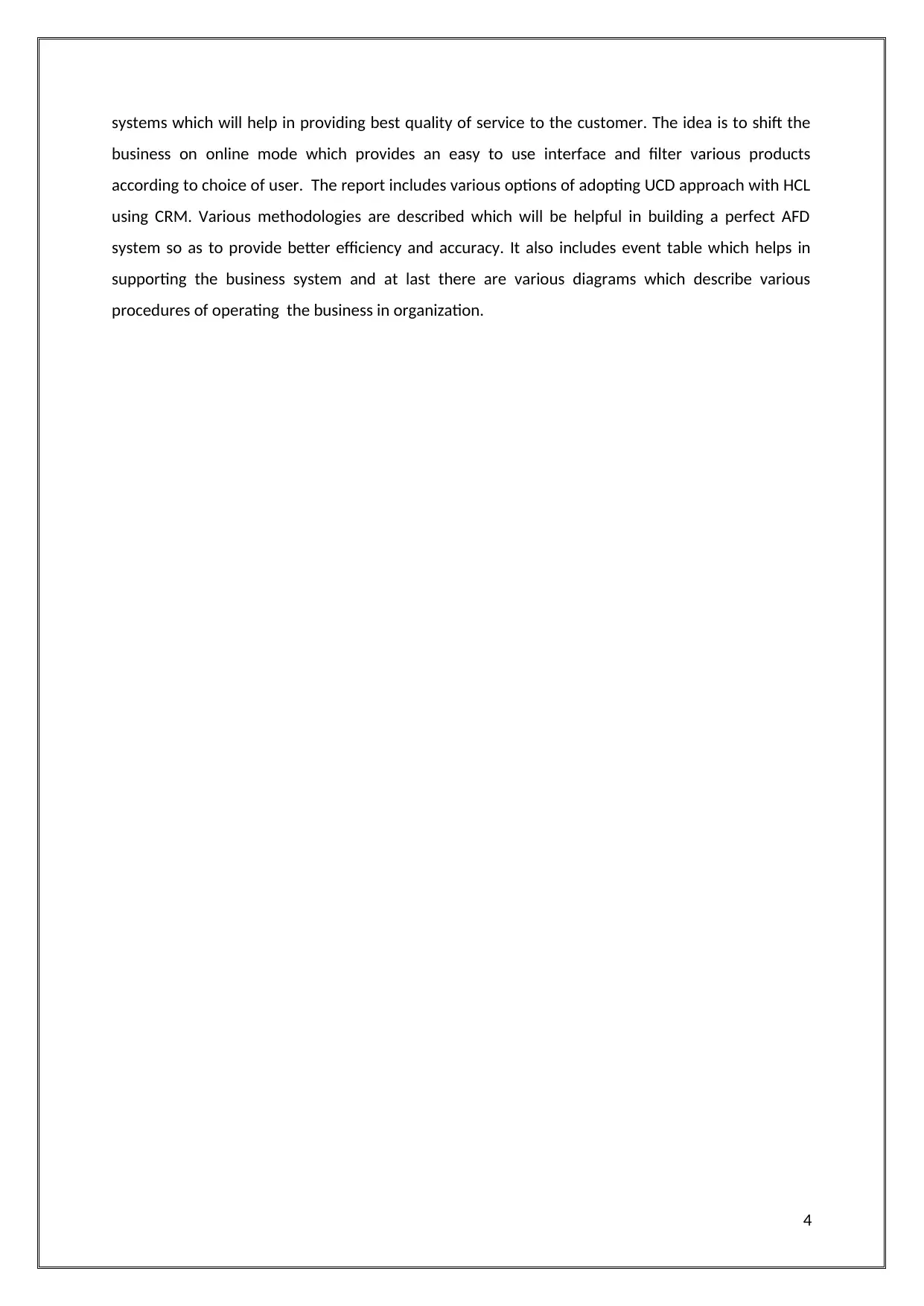
systems which will help in providing best quality of service to the customer. The idea is to shift the
business on online mode which provides an easy to use interface and filter various products
according to choice of user. The report includes various options of adopting UCD approach with HCL
using CRM. Various methodologies are described which will be helpful in building a perfect AFD
system so as to provide better efficiency and accuracy. It also includes event table which helps in
supporting the business system and at last there are various diagrams which describe various
procedures of operating the business in organization.
4
business on online mode which provides an easy to use interface and filter various products
according to choice of user. The report includes various options of adopting UCD approach with HCL
using CRM. Various methodologies are described which will be helpful in building a perfect AFD
system so as to provide better efficiency and accuracy. It also includes event table which helps in
supporting the business system and at last there are various diagrams which describe various
procedures of operating the business in organization.
4

Task 1: Report
There are various techniques provided when it comes to business system making. To make a good
business system there should be a proper plan and methodology which can result in a proper
business system. The various methodologies available for making business systems are agile,
incremental, iterative, etc. All the methodology start with discussing the plan of development that
includes all the requirements of the system . All the requirements are discussed with various officials
and a team is formed for the third specific purpose. Each and every team member is specialized in
one format and gives his/her opinion in the team meeting/ After discussing the requirements of the
system various digammas are made so as to show the functionality of the system. Diagrams such as
use case diagrams, data flow diagrams model the functionality of the system so that the team can
know about the working of the system in rough manner. The different approaches used in system
making are shown below:
1. Agile Approach:
It is similar to incremental model. Agile system is designed in quite fast cycles with the
incremental order. This results in the release of incremental outputs. Each release is tested
in a brief manner so that the methodology could be checked for issues. This results in
improving quality of the system. This methodology uses progressive development and
adaptive planning approach for its working. Here are some advantages and disadvantages
regarding this methodology:
Agile approach Advantages:
It is a continuous approach and thus provides and gain customer satisfaction.
The models working are placed quite fast.
It provides Continuous attention which is helpful in technical excellence.
The requirements could be changed afterward quickly.
Much helpful to the management team in features like purchasing and transaction
It provides interface that is user-friendly to the users of the system.
Agile approach Disadvantages:
Designing and documentation are not on a higher priority.
If requirements are not clearly specified the project can be disqualified.
5
There are various techniques provided when it comes to business system making. To make a good
business system there should be a proper plan and methodology which can result in a proper
business system. The various methodologies available for making business systems are agile,
incremental, iterative, etc. All the methodology start with discussing the plan of development that
includes all the requirements of the system . All the requirements are discussed with various officials
and a team is formed for the third specific purpose. Each and every team member is specialized in
one format and gives his/her opinion in the team meeting/ After discussing the requirements of the
system various digammas are made so as to show the functionality of the system. Diagrams such as
use case diagrams, data flow diagrams model the functionality of the system so that the team can
know about the working of the system in rough manner. The different approaches used in system
making are shown below:
1. Agile Approach:
It is similar to incremental model. Agile system is designed in quite fast cycles with the
incremental order. This results in the release of incremental outputs. Each release is tested
in a brief manner so that the methodology could be checked for issues. This results in
improving quality of the system. This methodology uses progressive development and
adaptive planning approach for its working. Here are some advantages and disadvantages
regarding this methodology:
Agile approach Advantages:
It is a continuous approach and thus provides and gain customer satisfaction.
The models working are placed quite fast.
It provides Continuous attention which is helpful in technical excellence.
The requirements could be changed afterward quickly.
Much helpful to the management team in features like purchasing and transaction
It provides interface that is user-friendly to the users of the system.
Agile approach Disadvantages:
Designing and documentation are not on a higher priority.
If requirements are not clearly specified the project can be disqualified.
5
⊘ This is a preview!⊘
Do you want full access?
Subscribe today to unlock all pages.

Trusted by 1+ million students worldwide
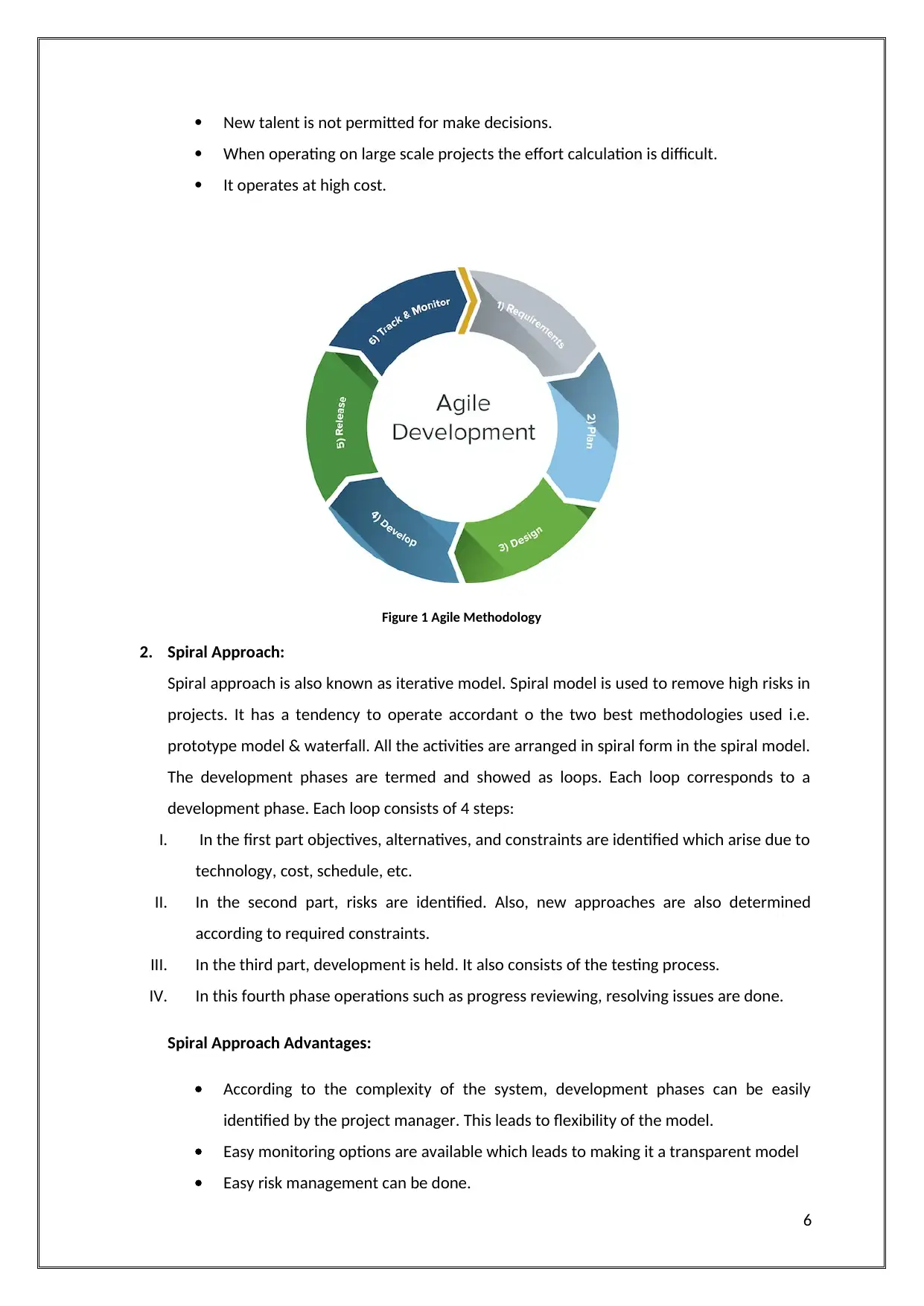
New talent is not permitted for make decisions.
When operating on large scale projects the effort calculation is difficult.
It operates at high cost.
Figure 1 Agile Methodology
2. Spiral Approach:
Spiral approach is also known as iterative model. Spiral model is used to remove high risks in
projects. It has a tendency to operate accordant o the two best methodologies used i.e.
prototype model & waterfall. All the activities are arranged in spiral form in the spiral model.
The development phases are termed and showed as loops. Each loop corresponds to a
development phase. Each loop consists of 4 steps:
I. In the first part objectives, alternatives, and constraints are identified which arise due to
technology, cost, schedule, etc.
II. In the second part, risks are identified. Also, new approaches are also determined
according to required constraints.
III. In the third part, development is held. It also consists of the testing process.
IV. In this fourth phase operations such as progress reviewing, resolving issues are done.
Spiral Approach Advantages:
According to the complexity of the system, development phases can be easily
identified by the project manager. This leads to flexibility of the model.
Easy monitoring options are available which leads to making it a transparent model
Easy risk management can be done.
6
When operating on large scale projects the effort calculation is difficult.
It operates at high cost.
Figure 1 Agile Methodology
2. Spiral Approach:
Spiral approach is also known as iterative model. Spiral model is used to remove high risks in
projects. It has a tendency to operate accordant o the two best methodologies used i.e.
prototype model & waterfall. All the activities are arranged in spiral form in the spiral model.
The development phases are termed and showed as loops. Each loop corresponds to a
development phase. Each loop consists of 4 steps:
I. In the first part objectives, alternatives, and constraints are identified which arise due to
technology, cost, schedule, etc.
II. In the second part, risks are identified. Also, new approaches are also determined
according to required constraints.
III. In the third part, development is held. It also consists of the testing process.
IV. In this fourth phase operations such as progress reviewing, resolving issues are done.
Spiral Approach Advantages:
According to the complexity of the system, development phases can be easily
identified by the project manager. This leads to flexibility of the model.
Easy monitoring options are available which leads to making it a transparent model
Easy risk management can be done.
6
Paraphrase This Document
Need a fresh take? Get an instant paraphrase of this document with our AI Paraphraser
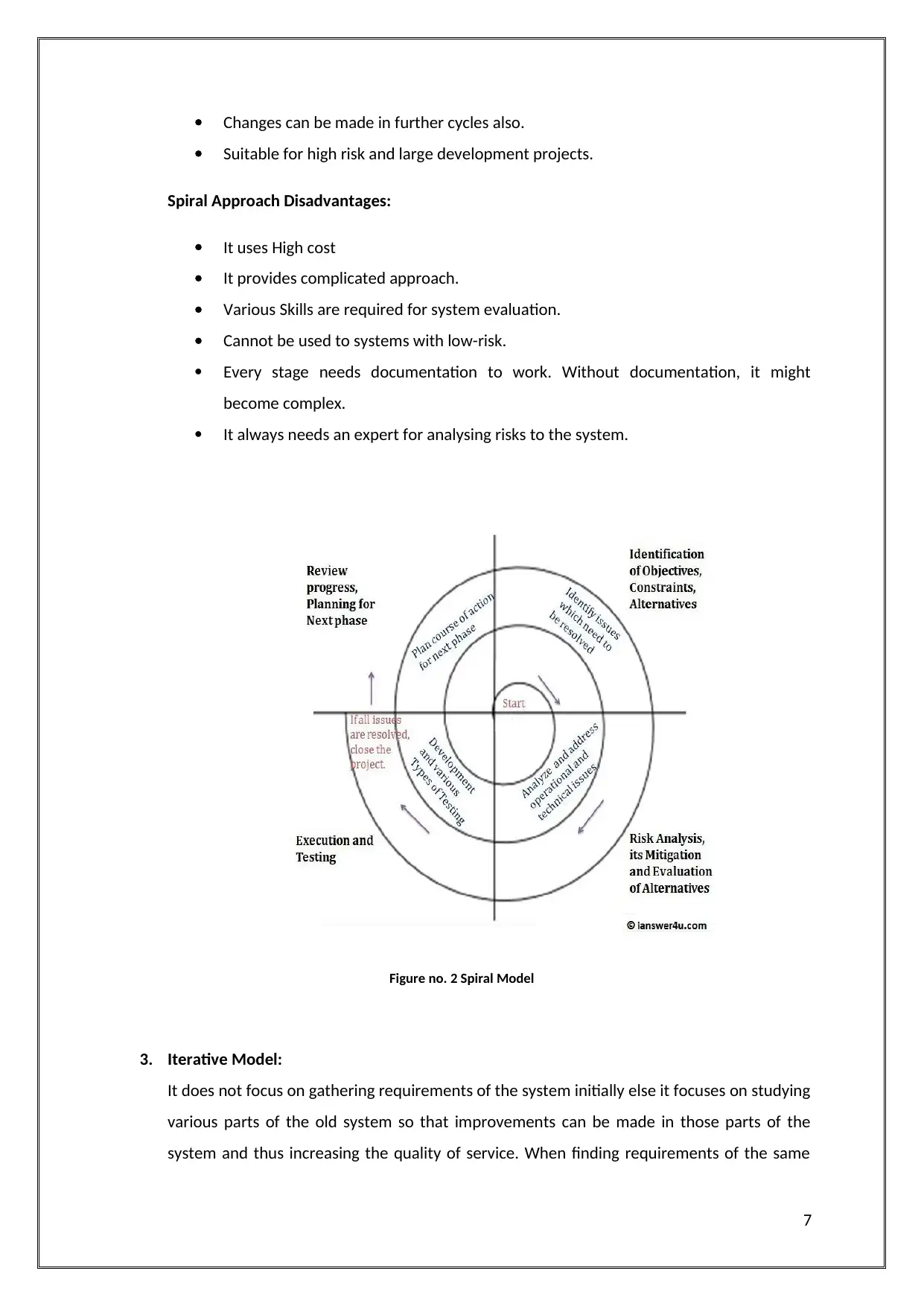
Changes can be made in further cycles also.
Suitable for high risk and large development projects.
Spiral Approach Disadvantages:
It uses High cost
It provides complicated approach.
Various Skills are required for system evaluation.
Cannot be used to systems with low-risk.
Every stage needs documentation to work. Without documentation, it might
become complex.
It always needs an expert for analysing risks to the system.
Figure no. 2 Spiral Model
3. Iterative Model:
It does not focus on gathering requirements of the system initially else it focuses on studying
various parts of the old system so that improvements can be made in those parts of the
system and thus increasing the quality of service. When finding requirements of the same
7
Suitable for high risk and large development projects.
Spiral Approach Disadvantages:
It uses High cost
It provides complicated approach.
Various Skills are required for system evaluation.
Cannot be used to systems with low-risk.
Every stage needs documentation to work. Without documentation, it might
become complex.
It always needs an expert for analysing risks to the system.
Figure no. 2 Spiral Model
3. Iterative Model:
It does not focus on gathering requirements of the system initially else it focuses on studying
various parts of the old system so that improvements can be made in those parts of the
system and thus increasing the quality of service. When finding requirements of the same
7
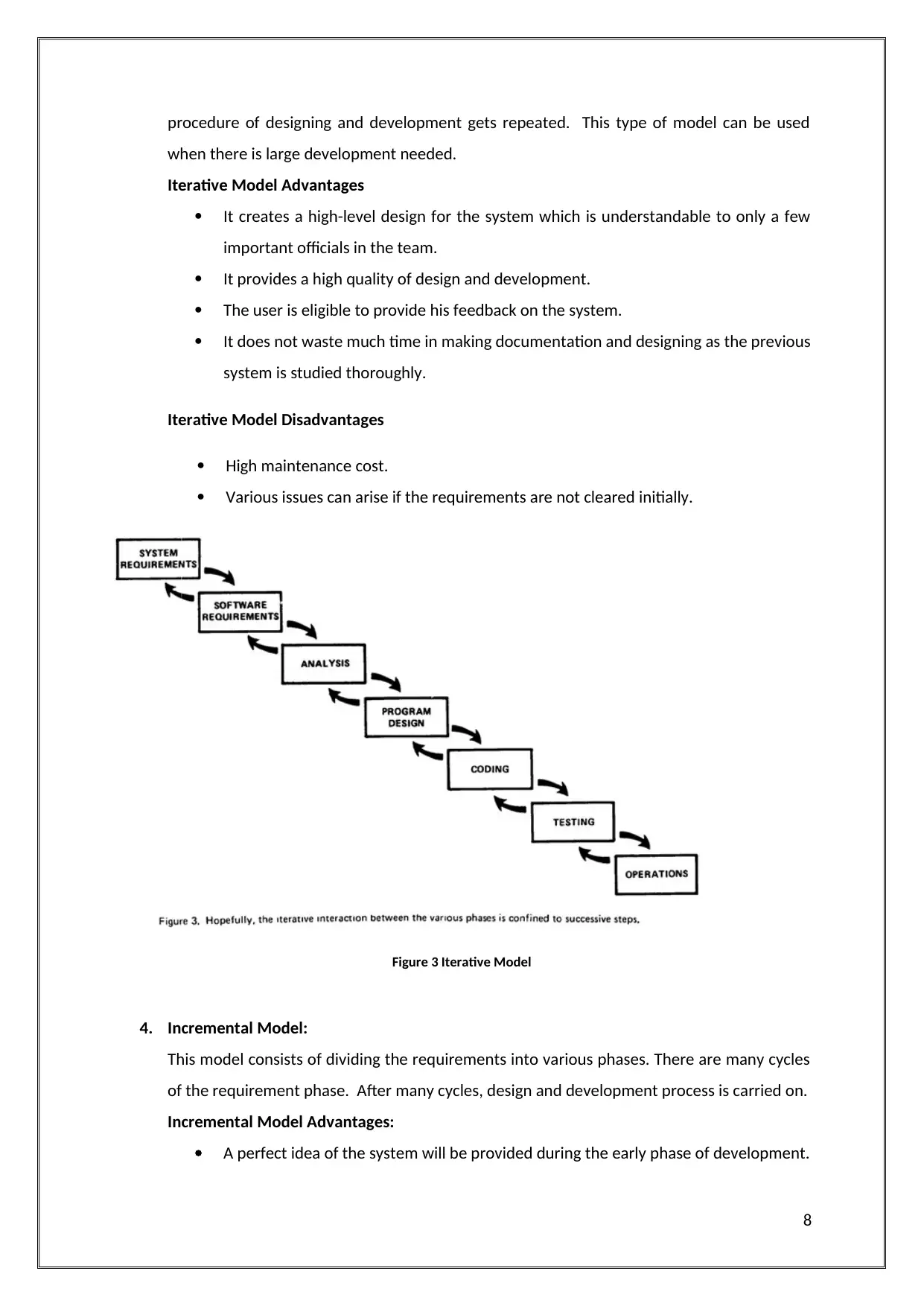
procedure of designing and development gets repeated. This type of model can be used
when there is large development needed.
Iterative Model Advantages
It creates a high-level design for the system which is understandable to only a few
important officials in the team.
It provides a high quality of design and development.
The user is eligible to provide his feedback on the system.
It does not waste much time in making documentation and designing as the previous
system is studied thoroughly.
Iterative Model Disadvantages
High maintenance cost.
Various issues can arise if the requirements are not cleared initially.
Figure 3 Iterative Model
4. Incremental Model:
This model consists of dividing the requirements into various phases. There are many cycles
of the requirement phase. After many cycles, design and development process is carried on.
Incremental Model Advantages:
A perfect idea of the system will be provided during the early phase of development.
8
when there is large development needed.
Iterative Model Advantages
It creates a high-level design for the system which is understandable to only a few
important officials in the team.
It provides a high quality of design and development.
The user is eligible to provide his feedback on the system.
It does not waste much time in making documentation and designing as the previous
system is studied thoroughly.
Iterative Model Disadvantages
High maintenance cost.
Various issues can arise if the requirements are not cleared initially.
Figure 3 Iterative Model
4. Incremental Model:
This model consists of dividing the requirements into various phases. There are many cycles
of the requirement phase. After many cycles, design and development process is carried on.
Incremental Model Advantages:
A perfect idea of the system will be provided during the early phase of development.
8
⊘ This is a preview!⊘
Do you want full access?
Subscribe today to unlock all pages.

Trusted by 1+ million students worldwide
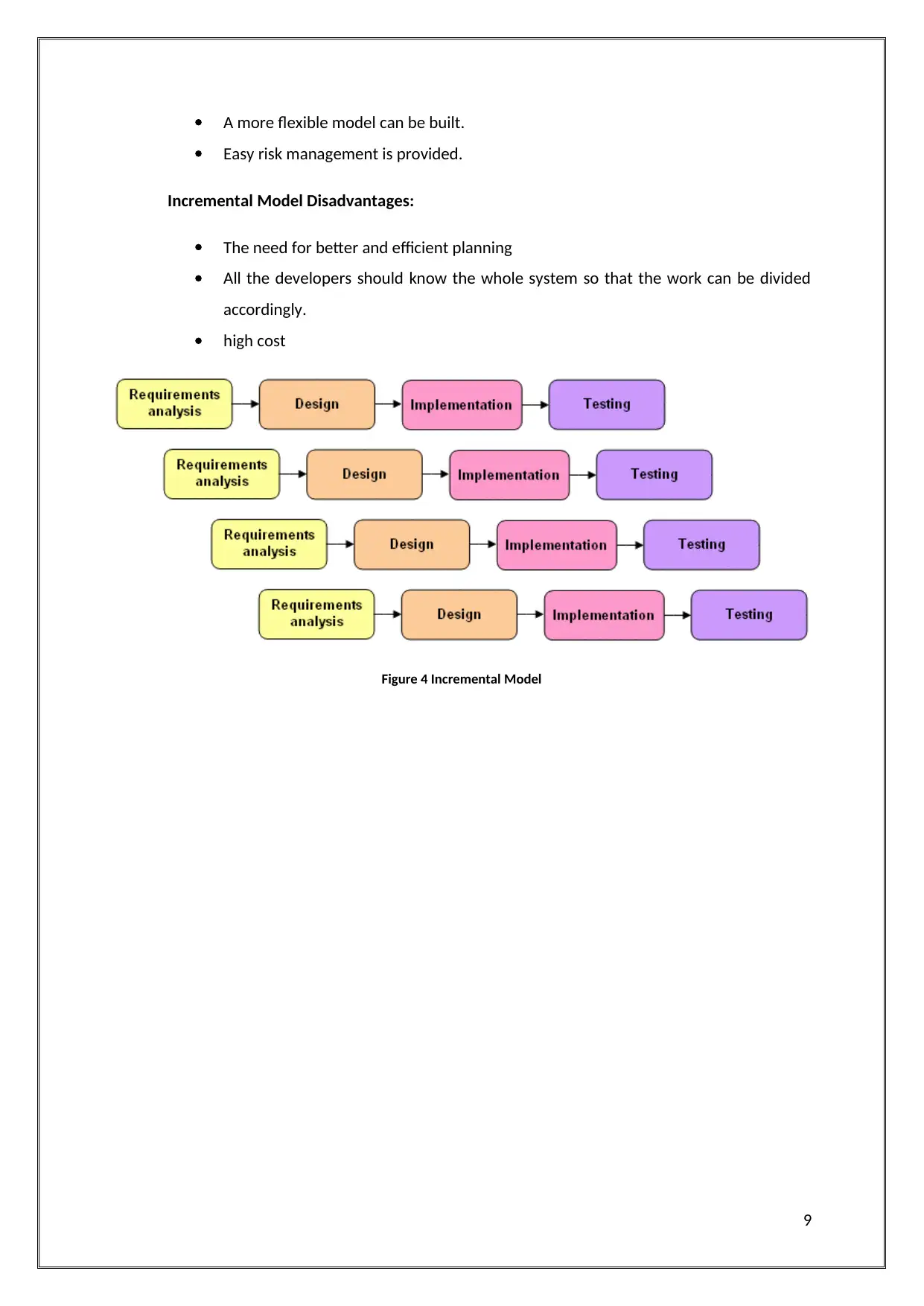
A more flexible model can be built.
Easy risk management is provided.
Incremental Model Disadvantages:
The need for better and efficient planning
All the developers should know the whole system so that the work can be divided
accordingly.
high cost
Figure 4 Incremental Model
9
Easy risk management is provided.
Incremental Model Disadvantages:
The need for better and efficient planning
All the developers should know the whole system so that the work can be divided
accordingly.
high cost
Figure 4 Incremental Model
9
Paraphrase This Document
Need a fresh take? Get an instant paraphrase of this document with our AI Paraphraser
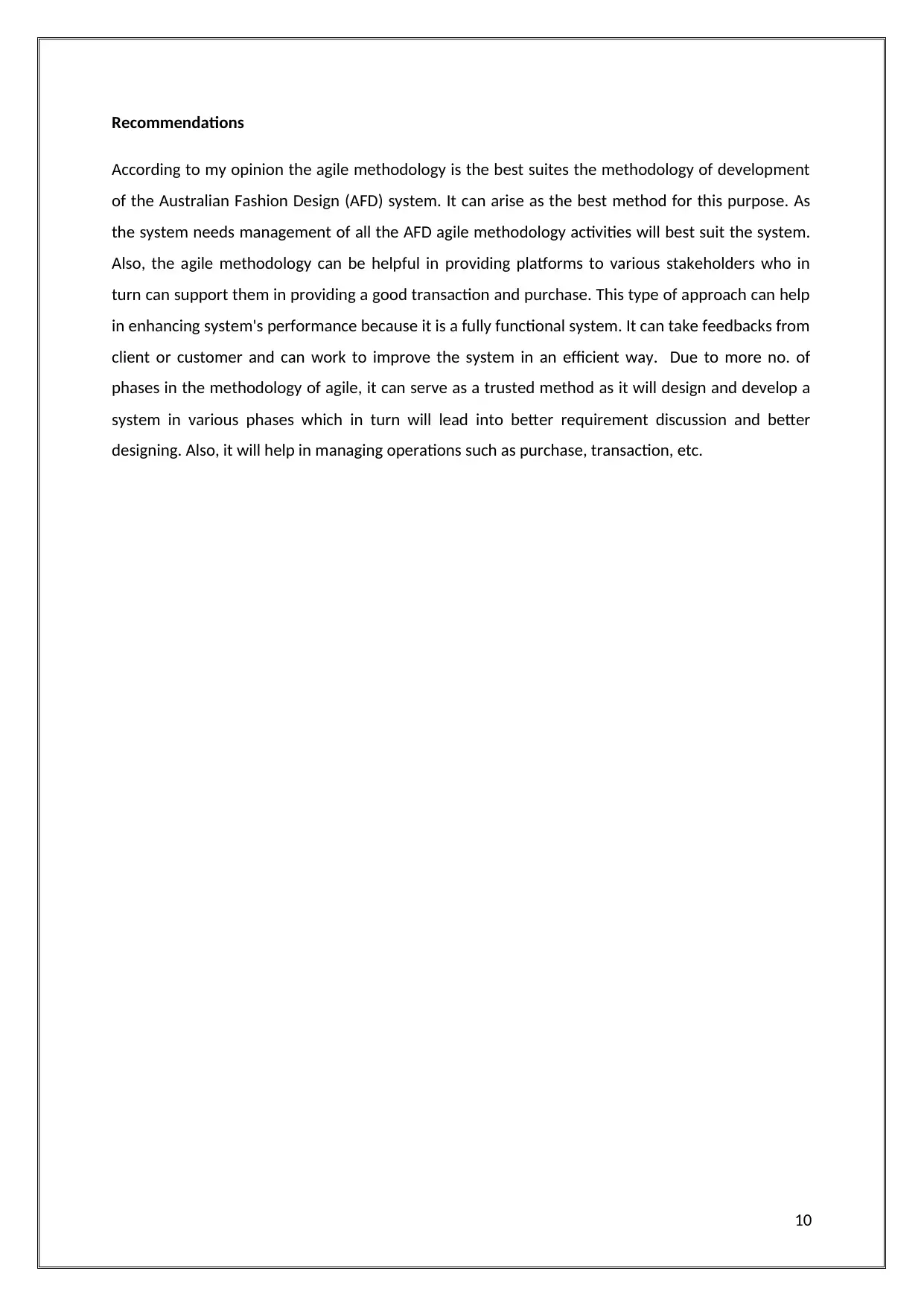
Recommendations
According to my opinion the agile methodology is the best suites the methodology of development
of the Australian Fashion Design (AFD) system. It can arise as the best method for this purpose. As
the system needs management of all the AFD agile methodology activities will best suit the system.
Also, the agile methodology can be helpful in providing platforms to various stakeholders who in
turn can support them in providing a good transaction and purchase. This type of approach can help
in enhancing system's performance because it is a fully functional system. It can take feedbacks from
client or customer and can work to improve the system in an efficient way. Due to more no. of
phases in the methodology of agile, it can serve as a trusted method as it will design and develop a
system in various phases which in turn will lead into better requirement discussion and better
designing. Also, it will help in managing operations such as purchase, transaction, etc.
10
According to my opinion the agile methodology is the best suites the methodology of development
of the Australian Fashion Design (AFD) system. It can arise as the best method for this purpose. As
the system needs management of all the AFD agile methodology activities will best suit the system.
Also, the agile methodology can be helpful in providing platforms to various stakeholders who in
turn can support them in providing a good transaction and purchase. This type of approach can help
in enhancing system's performance because it is a fully functional system. It can take feedbacks from
client or customer and can work to improve the system in an efficient way. Due to more no. of
phases in the methodology of agile, it can serve as a trusted method as it will design and develop a
system in various phases which in turn will lead into better requirement discussion and better
designing. Also, it will help in managing operations such as purchase, transaction, etc.
10
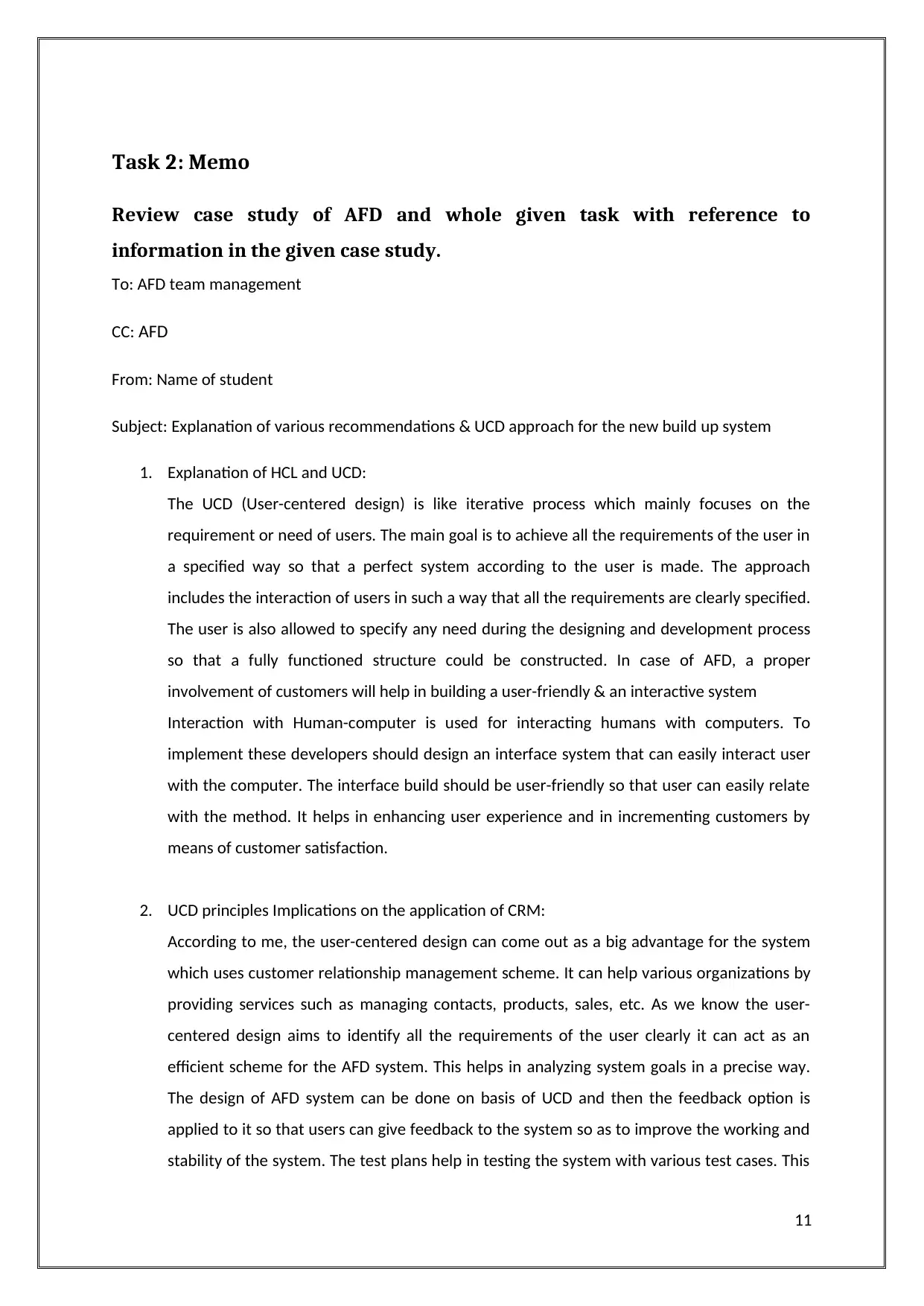
Task 2: Memo
Review case study of AFD and whole given task with reference to
information in the given case study.
To: AFD team management
CC: AFD
From: Name of student
Subject: Explanation of various recommendations & UCD approach for the new build up system
1. Explanation of HCL and UCD:
The UCD (User-centered design) is like iterative process which mainly focuses on the
requirement or need of users. The main goal is to achieve all the requirements of the user in
a specified way so that a perfect system according to the user is made. The approach
includes the interaction of users in such a way that all the requirements are clearly specified.
The user is also allowed to specify any need during the designing and development process
so that a fully functioned structure could be constructed. In case of AFD, a proper
involvement of customers will help in building a user-friendly & an interactive system
Interaction with Human-computer is used for interacting humans with computers. To
implement these developers should design an interface system that can easily interact user
with the computer. The interface build should be user-friendly so that user can easily relate
with the method. It helps in enhancing user experience and in incrementing customers by
means of customer satisfaction.
2. UCD principles Implications on the application of CRM:
According to me, the user-centered design can come out as a big advantage for the system
which uses customer relationship management scheme. It can help various organizations by
providing services such as managing contacts, products, sales, etc. As we know the user-
centered design aims to identify all the requirements of the user clearly it can act as an
efficient scheme for the AFD system. This helps in analyzing system goals in a precise way.
The design of AFD system can be done on basis of UCD and then the feedback option is
applied to it so that users can give feedback to the system so as to improve the working and
stability of the system. The test plans help in testing the system with various test cases. This
11
Review case study of AFD and whole given task with reference to
information in the given case study.
To: AFD team management
CC: AFD
From: Name of student
Subject: Explanation of various recommendations & UCD approach for the new build up system
1. Explanation of HCL and UCD:
The UCD (User-centered design) is like iterative process which mainly focuses on the
requirement or need of users. The main goal is to achieve all the requirements of the user in
a specified way so that a perfect system according to the user is made. The approach
includes the interaction of users in such a way that all the requirements are clearly specified.
The user is also allowed to specify any need during the designing and development process
so that a fully functioned structure could be constructed. In case of AFD, a proper
involvement of customers will help in building a user-friendly & an interactive system
Interaction with Human-computer is used for interacting humans with computers. To
implement these developers should design an interface system that can easily interact user
with the computer. The interface build should be user-friendly so that user can easily relate
with the method. It helps in enhancing user experience and in incrementing customers by
means of customer satisfaction.
2. UCD principles Implications on the application of CRM:
According to me, the user-centered design can come out as a big advantage for the system
which uses customer relationship management scheme. It can help various organizations by
providing services such as managing contacts, products, sales, etc. As we know the user-
centered design aims to identify all the requirements of the user clearly it can act as an
efficient scheme for the AFD system. This helps in analyzing system goals in a precise way.
The design of AFD system can be done on basis of UCD and then the feedback option is
applied to it so that users can give feedback to the system so as to improve the working and
stability of the system. The test plans help in testing the system with various test cases. This
11
⊘ This is a preview!⊘
Do you want full access?
Subscribe today to unlock all pages.

Trusted by 1+ million students worldwide
1 out of 24
Related Documents
Your All-in-One AI-Powered Toolkit for Academic Success.
+13062052269
info@desklib.com
Available 24*7 on WhatsApp / Email
![[object Object]](/_next/static/media/star-bottom.7253800d.svg)
Unlock your academic potential
Copyright © 2020–2025 A2Z Services. All Rights Reserved. Developed and managed by ZUCOL.





